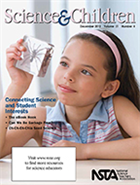Connecting science and students' interests
By Mary Bigelow
Posted on 2013-12-23
 It’s hard to think of a science topic that children are not interested in! Just about anything will stimulate their thinking and inquisitiveness. The cover of this issue brought back memories of these interests—I had a set of specimens embedded in plastic blocks. Just putting some out at the exploration table in my classroom let to many discussions. (The favorites were skeletons of small bats and garter snakes.) The articles in this issue offer resources and suggested strategies for tapping into students’ interests to stimulate engaging science instruction.
It’s hard to think of a science topic that children are not interested in! Just about anything will stimulate their thinking and inquisitiveness. The cover of this issue brought back memories of these interests—I had a set of specimens embedded in plastic blocks. Just putting some out at the exploration table in my classroom let to many discussions. (The favorites were skeletons of small bats and garter snakes.) The articles in this issue offer resources and suggested strategies for tapping into students’ interests to stimulate engaging science instruction.
You know it’s the gift-giving season when commercials for Chia Pets appear on television! Who would think that these could be learning tools? Students explore the chia seed’s nutritional value and the growth requirements for its sprouts, as described in Ch-Ch-Ch-Chia Seed Science*. Using a 5e lesson, teachers and students explored concepts in germination and designed fair tests to study the factors that influence it. [SciLinks: Factors Affecting Plant Growth, How Do Plants Grow?]
The authors of The eBook Hook* describe a classroom research project in which they investigated how nonfiction eBooks could engage students in studying topics such as landforms. Students shared their perceptions of using an electronic format, in terms of finding information, the value of features such as pronunciation guides and dictionaries, and their attitudes toward reading. [SciLinks: What Are Landforms?]
Making Connections Between the Digital and Physical World* shows how a game such as “Angry Birds” can spark student interest in physical science concepts and shows that there’s more to the game than bird and pigs. While learning about the concepts, students design, test, and modify a real, 3-D version of the game. [SciLinks: Kinetic and Potential Energy, Gravity, Friction]
Even if you’ve never used the outdoors as a classroom, the article Exploring the Wild World of Wiggly Worms has suggestions for taking young students outdoors and exploring worms with a 5e lesson. They (and the teacher) can get their hands dirty while investigating earthworm habitats and behaviors. The authors also provide a list of related fiction and nonfiction trade books on the topic. [SciLinks: Earthworms]
The school cafeteria as a source of data? Can We Be Garbage Free?* describes an investigation in which students observed (without touching) waste from the cafeteria and tallied different categories. They then formulated their own questions about the type and frequency of materials thrown away. Students presented their findings and suggestions to the maintenance staff [SciLinks: Waste Management]
Additional ideas for student investigations based on students’ interests are included in the articles Our Environment* (students pose a scientific question and plan an investigation to answer that question), Catch Me If You Can (kindergarten students design a “trap” for an intruding character), Happy Birthday (students learn about seasons and the length of daylight at different times of the year when their birthdays fall), and Is It Made of Parts?* (a formative assessment probe).
Now We’re Cooking* shows how cooking and science topics are related: states of matter, measuring, properties of materials, changes in matter, fractions. The article includes a “recipe” or procedure for making ice cream. [SciLinks: States of Matter]
* Many of these articles have extensive resources to share, so check out the Connections for this issue (December 2013). Even if the article does not quite fit with your lesson agenda, there are ideas for handouts, background information sheets, data sheets, rubrics, and other resources.
Disclaimer: The views expressed in this blog post are those of the author(s) and do not necessarily reflect the official position of the National Science Teaching Association (NSTA).


